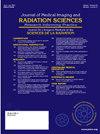推进前列腺近距离治疗教育:虚拟现实模拟器和插针模块的评估
IF 2
Q3 RADIOLOGY, NUCLEAR MEDICINE & MEDICAL IMAGING
Journal of Medical Imaging and Radiation Sciences
Pub Date : 2025-05-01
DOI:10.1016/j.jmir.2025.101922
引用次数: 0
摘要
临床医生在前列腺近距离治疗教育中面临挑战,部分原因是现场培训受限于手术室(OR)有限的时间和空间。目前,放射治疗课程没有有效地将近距离治疗教育与临床培训结合起来。虚拟现实(VR)为卫生专业教育提供了可扩展、可访问和异步的解决方案,使其成为解决培训挑战的有前途的工具。为了缩小教育差距,我们的机构开发了一个带有插针模块的虚拟现实培训模拟器,旨在提高对前列腺近距离治疗工作流程的理解。该项目的这一阶段的目的是评估VR模拟器在提高放射治疗师、医学物理学家和放射肿瘤学家在前列腺近距离治疗实践中的感知信心水平方面的有效性。使用开源的三维建模工具和游戏引擎来开发模拟,允许用户使用市售的VR耳机查看近距离治疗OR的虚拟副本并与之交互。在开发过程中使用了迭代反馈循环,以确保VR模拟器功能对用户来说是真实和直观的。开发了一个前列腺近距离治疗培训模块来模拟针头插入工作流程。这项研究的参与者被要求完成一个虚拟的针头插入,然后回答有关他们经历的问题。开发了前后调查,以评估用户在完成模块之前和之后回忆和解释针头插入工作流程的感知信心,并记录任何与vr相关的不良影响。每次调查由6个李克特量表问题组成,其中4个配对问题在调查前和调查后都是相同的,以便对回答进行直接比较。还包括开放式问题,以收集参与者的人口统计数据、反馈和改进建议。配对问卷的回答采用Wilcoxon符号秩检验进行分析。结果或益处/挑战27名参与者完成了前列腺近距离治疗插针培训模块,包括放射治疗师(59%)、放射肿瘤学家(26%)和医学物理学家(15%)。参与者调查前和调查后的Wilcoxon sign -rank检验结果显示,完成模块后,在回忆工作流程步骤(W=355, p<0.01)、解释步骤(W=347, p<0.01)、识别设备(W=355, p<0.01)和解释设备功能(W=354, p<0.01)方面的信心排名有所提高。19%的参与者在使用VR模拟器时经历了轻微的晕动病。从开放式问题中收集的反馈是积极的,同时强调了需要改进的领域。结论/影响本研究的结果证明了VR模拟器在前列腺近距离治疗临床医生培训中的教育潜力。需要更多临床医生的进一步评估,以帮助进一步完善我们的培训模块,目标是为近距离治疗的受训者提供这种学习经验。详细介绍前列腺近距离治疗过程中其他步骤的其他模块目前正在开发和评估中。未来的方向包括结合增强现实,让参与者在虚拟空间中与高保真的幻影互动,以及开发用于妇科近距离放射治疗的VR培训模块。本文章由计算机程序翻译,如有差异,请以英文原文为准。
Advancing Education for Prostate Brachytherapy: Evaluation of a Virtual Reality Simulator and Needle Insertion Module
Purpose/Aim
Clinicians face challenges in prostate brachytherapy education, partly because in-person training is constrained by limited time and space in the operating room (OR). Currently, radiation therapy curriculum does not effectively integrate brachytherapy education and clinical training. Virtual reality (VR) offers a scalable, accessible, and asynchronous solution for health professions education, making it a promising tool for addressing training challenges. To bridge the educational gap, our institution developed a VR training simulator with a needle insertion module designed to improve understanding of prostate brachytherapy workflows. The aim of this phase of the project was to evaluate the effectiveness of the VR simulator in improving the perceived confidence levels of radiation therapists, medical physicists, and radiation oncologists in prostate brachytherapy practice.
Methods/Process
An open-sourced three-dimensional modeling tool and game engine were used to develop a simulation allowing users to view and interact with a virtual replica of a brachytherapy OR using a commercially available VR headset. An iterative feedback loop was used during development to ensure that the VR simulator features were realistic and intuitive for users. A prostate brachytherapy training module was developed to simulate a needle insertion workflow. Participants in this study were asked to complete a virtual needle insertion and then answer questions regarding their experiences. Pre- and post-surveys were developed to assess the perceived confidence of users in recalling and explaining the needle insertion workflow before and after completing the module, as well as documenting any VR-related adverse effects. Each survey consisted of 6 Likert-scale questions, including 4 paired questions that were identical in both the pre- and post-survey to enable direct comparison of responses. Open ended questions were also included to gather participant demographics, feedback, and suggestions for improvement. Responses from paired questionnaires were analyzed using Wilcoxon signed-rank tests.
Results or Benefits/Challenges
The prostate brachytherapy needle insertion training module was completed by 27 participants, including radiation therapists (59%), radiation oncologists (26%), and medical physicists (15%). Wilcoxon signed-rank test results of participant pre- and post-survey responses demonstrated improved confidence rankings for recalling workflow steps (W=355, p<0.01), explaining steps (W=347, p<0.01), identifying equipment (W=355, p<0.01) and explaining equipment function (W=354, p<0.01) following completion of the module. Minor motion sickness with use of the VR simulator was experienced by 19% of participants. Feedback gathered from open-ended questions was positive, while highlighting areas for improvement.
Conclusions/Impact
The results of this study demonstrate the educational potential of our VR simulator for clinicians training in prostate brachytherapy. Further evaluation with a larger group of clinicians is required to help further refine our training module with the goal of making this learning experience available to trainees in brachytherapy. Additional modules detailing other steps within the prostate brachytherapy process are currently under development and evaluation. Future directions include incorporation of augmented reality to allow participants to interact with high fidelity phantoms in the virtual space and development of VR training modules for gynecological brachytherapy.
求助全文
通过发布文献求助,成功后即可免费获取论文全文。
去求助
来源期刊

Journal of Medical Imaging and Radiation Sciences
RADIOLOGY, NUCLEAR MEDICINE & MEDICAL IMAGING-
CiteScore
2.30
自引率
11.10%
发文量
231
审稿时长
53 days
期刊介绍:
Journal of Medical Imaging and Radiation Sciences is the official peer-reviewed journal of the Canadian Association of Medical Radiation Technologists. This journal is published four times a year and is circulated to approximately 11,000 medical radiation technologists, libraries and radiology departments throughout Canada, the United States and overseas. The Journal publishes articles on recent research, new technology and techniques, professional practices, technologists viewpoints as well as relevant book reviews.
 求助内容:
求助内容: 应助结果提醒方式:
应助结果提醒方式:


